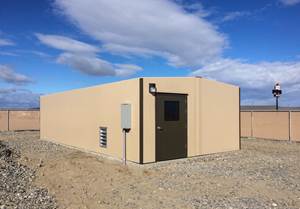UMaine professor's composite arch bridge earns White House honors
Habib Dagher, the primary inventor of the award-winning composite arch bridge system, will be recognized as a 2015 White House Transportation Champion of Change.
Habib Dagher, founding director of the University of Maine’s Advanced Structures and Composites Center, will be recognized as a 2015 White House Transportation Champion of Change on Oct. 13. Dagher is the primary inventor of the award-winning composite arch bridge system, also known as the “Bridge-in-a-Backpack.”
U.S. Secretary of Transportation Anthony Foxx will recognize 11 of the nation’s top transportation innovators for their exemplary leadership in advancing transportation and leading change that benefits our nation’s transportation system.
The White House Champions of Change Program honors Americans who are empowering and inspiring other members of their communities. At the event, honorees will have the opportunity to highlight their efforts in advancing transportation during a panel discussion.
“Dr. Dagher has long been an innovative force in Maine, and we are delighted that his work is being recognized so prominently by the White House,” said Senators Collins and King in a joint statement. “The University of Maine continues to prove that it is a first-class research institution, and Dr. Dagher and his team at the Composites Center are exemplary of that excellence.”
“Congratulations to Dr. Habib Dagher on being recognized as a White House Transportation Champion of Change,” said Congressman Bruce Poliquin. “Dr. Dagher’s composite arch bridge system, also called Bridge-in-a-Backpack, is the type of innovation that will help strengthen and modernize our transportation system. Again, congratulations to Dr. Dagher, and the University of Maine, on earning this terrific achievement and I look forward to driving across one of your composite arch bridges in the future.”
The American Society of Civil Engineers (ASCE) nominated Dagher.
The Composite Arch Bridge System is a lightweight, corrosion resistant system for short to medium span bridge construction using FRP composite arch tubes that start out flat and packed in a bag. The tubes are inflated and bent to any curvature over a mold and infused with a resin. The tubes can cure in three hours, resulting in a lightweight curved hollow arch twice as strong as steel, which is then filled with concrete on site. Prior to placing the concrete, a lightweight 60 ft span arch can be lifted into place by two people. The FRP tubes serve three functions: they act as exoskeleton reinforcement for the concrete, formwork for the concrete, and as a protective layer for the concrete. The patented bridge technology saves both time and money, reduces the carbon footprint of the bridge by 30% compared to current technologies, and provides for up to a 100-year life.
UMaine has licensed the composite arch bridge technology to a private start-up company, Advanced Infrastructure Technologies (AIT), who designs and builds these bridges. Some roadway bridges have been built in less than two weeks, including the time it takes to remove the existing structure – this means less road closures and traffic disruptions. In 2014, the Composite Arch Bridge system was approved in the American Association of State Highway and Transportation Officials (AASHTO) bridge code, the first FRP composite bridge system to be approved in the US bridge design code.
“This award honors over a decade of ground breaking research by Habib and the UMaine team and highlights the importance of our continued partnership in advancing the nation’s transportation industry. We are honored to be commercializing the composite arch bridge system across the globe,” said Brit Svoboda, Chairman and CEO of AIT.
Composite arch bridges have been installed in 18 locations in the U.S. and beyond by AIT.
Dagher and the UMaine Composites Center have received top industry awards for the composite arch bridge technology, including the 2011 Charles Pankow Award for Innovation by the American Society of Civil Engineers (ASCE), the 2011 Engineering Excellence Awards by the American Council of Engineering Companies (ACEC), and the 2010 Most Creative Product Award by the American Composites Manufacturers Association (ACMA).
Related Content
Composite rebar for future infrastructure
GFRP eliminates risk of corrosion and increases durability fourfold for reinforced concrete that meets future demands as traffic, urbanization and extreme weather increase.
Read MoreComposite buildings go monocoque
Superior protection from the elements plus fast, affordable installation and maintenance have quickly made Orenco Composites’ DuraFiber buildings an attractive choice for water and wastewater, communications, transportation and power industry outbuildings.
Read MoreMaterials & Processes: Fibers for composites
The structural properties of composite materials are derived primarily from the fiber reinforcement. Fiber types, their manufacture, their uses and the end-market applications in which they find most use are described.
Read MoreMaterials & Processes: Composites fibers and resins
Compared to legacy materials like steel, aluminum, iron and titanium, composites are still coming of age, and only just now are being better understood by design and manufacturing engineers. However, composites’ physical properties — combined with unbeatable light weight — make them undeniably attractive.
Read MoreRead Next
Composites end markets: Energy (2024)
Composites are used widely in oil/gas, wind and other renewable energy applications. Despite market challenges, growth potential and innovation for composites continue.
Read MoreCW’s 2024 Top Shops survey offers new approach to benchmarking
Respondents that complete the survey by April 30, 2024, have the chance to be recognized as an honoree.
Read MoreFrom the CW Archives: The tale of the thermoplastic cryotank
In 2006, guest columnist Bob Hartunian related the story of his efforts two decades prior, while at McDonnell Douglas, to develop a thermoplastic composite crytank for hydrogen storage. He learned a lot of lessons.
Read More














.jpg;maxWidth=300;quality=90)











